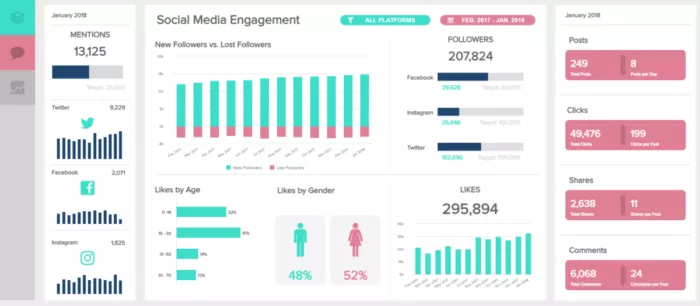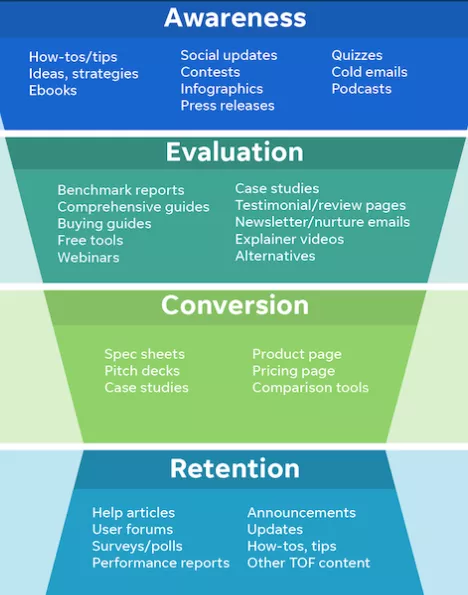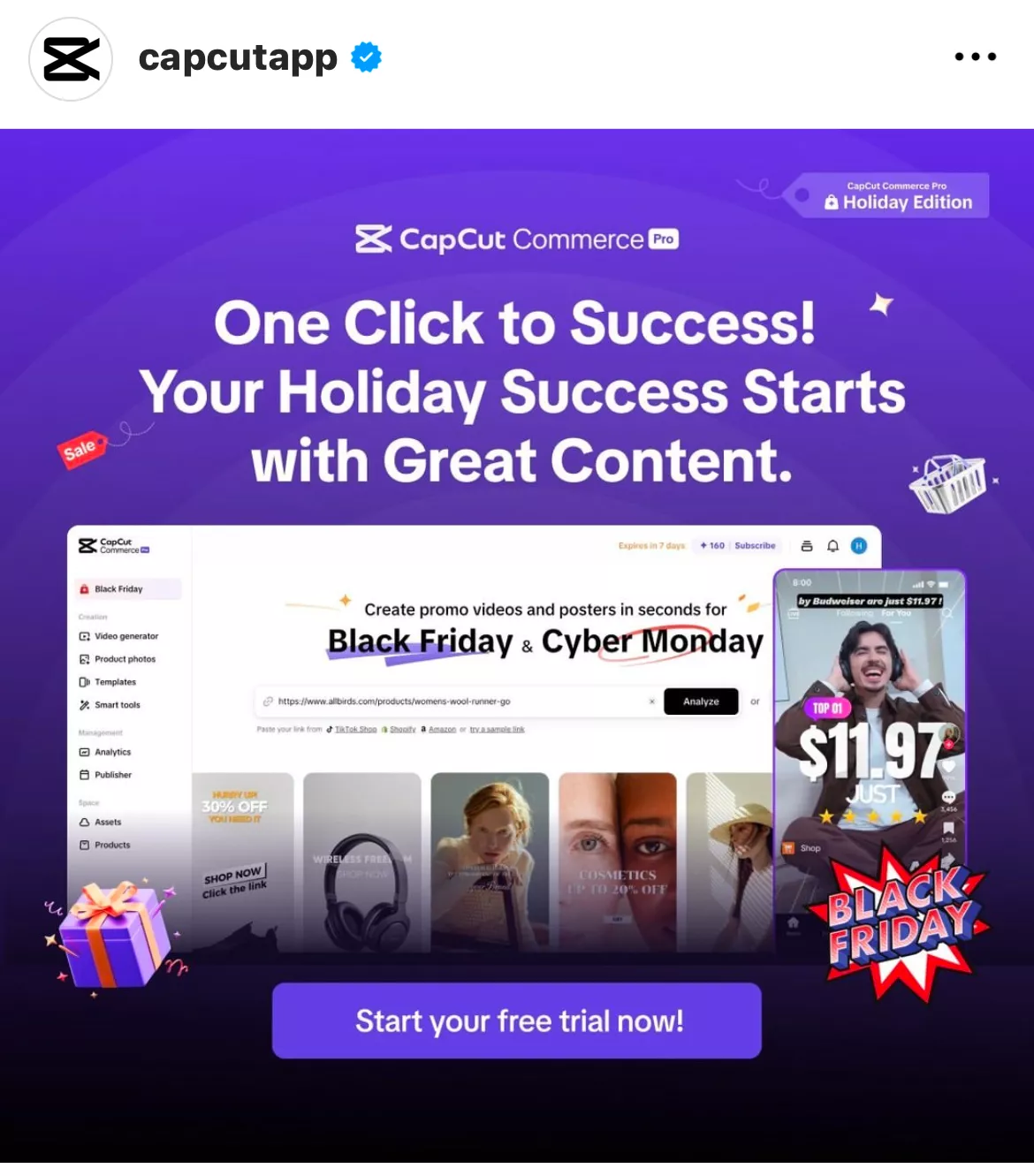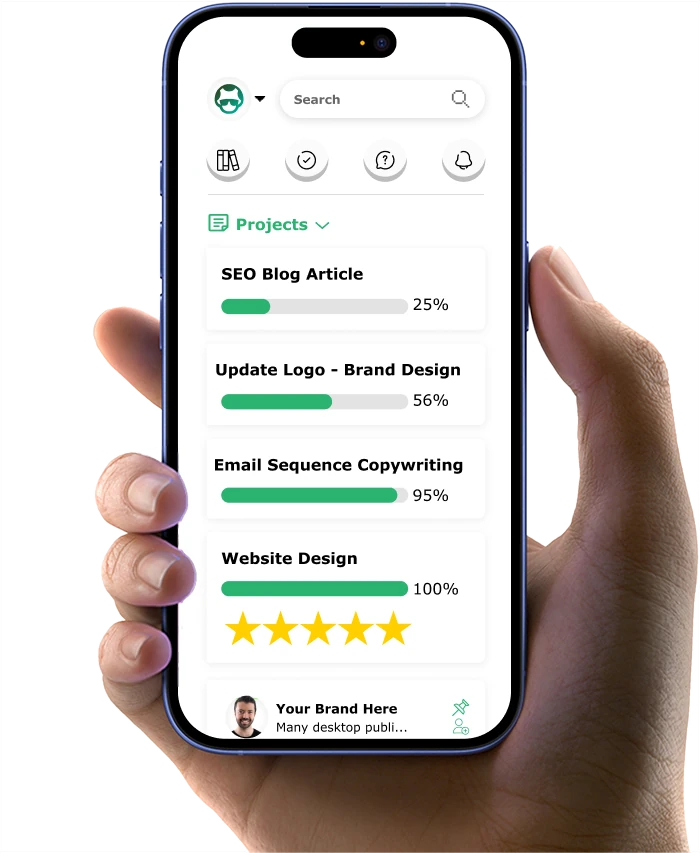Paid + Organic: 11 Ways to Maximize Content Reach

You've spent hours creating the perfect social media post, but when you check the analytics, only a tiny fraction of your followers actually saw it. Using paid ads to amplify organic content has become essential for businesses wanting their message to reach their target audience.
This problem is real - organic reach on Facebook has plummeted to where now only about one in every twenty followers sees your non-promoted content. Frustrating, right?
We've been there too. Despite all your hard work creating quality content, it simply isn't reaching enough people to make a real impact. This visibility challenge has pushed many businesses to dedicate a significant portion of their marketing budget to social media ads just to be seen.
You're not alone in this struggle. Most marketers now mix paid and organic social media to maximize their reach. This smart combination gives you the best of both worlds - the trust-building power of organic content plus the targeted reach of paid promotion.
Ready to stop shouting into the void? This article will show you exactly how to give your best content the visibility it deserves, without draining your budget:
- Discover the engagement threshold formula that reveals which content is worth your promotion dollars
- Master the content modification blueprint that turns ordinary posts into conversion machines
- Unlock the sequential retargeting framework that guides prospects naturally through your content journey
- Learn the hidden platform timing matrix that can double your content visibility overnight
- Implement the creative testing system that continuously improves results while keeping costs in check
Your content deserves to be seen. Let's make that happen, starting right now...
If you want to get your marketing work done for your business (or for your clients’), then you HAVE to learn more how you can delegate unlimited marketing projects & tasks without the headaches of hiring. Download this free guide: 33 Examples of Marketing Projects You Can Delegate to Growbo
Method #1: Analyzing Content Performance
You already create organic content for your social channels, but how do you know which pieces deserve your advertising dollars? The answer lies in using paid ads to amplify organic content that's already showing signs of success. SEMrush reports that over 60% of businesses use paid channels to boost content distribution This data-driven approach helps you maximize your return on ad spend.
Start by analyzing your existing organic content to identify posts that have naturally resonated with your audience. Look for engagement metrics like comments, shares, and click-through rates rather than just likes or impressions. These deeper engagement signals indicate content that truly connects with your audience and will likely perform well when amplified.

You'll need the right tools to track this performance effectively. Platforms like Facebook Insights, Instagram Analytics, or third-party tools such as Sprout Social or Hootsuite can help you identify your top-performing organic content. These tools allow you to sort and filter your posts by various engagement metrics, making it easier to spot amplification opportunities.
Here's a practical approach: set specific engagement thresholds for different types of content on each platform. For example, you might decide to amplify Facebook posts that achieve above 4% engagement rate, Instagram posts above 5%, or LinkedIn posts above 3%. These thresholds should be based on your historical performance data and industry benchmarks.
Remember that timing matters too. The best window for amplification is typically within 24-48 hours after posting, while the content is still fresh but has had enough time to generate initial organic engagement data. This allows you to capitalize on content that's already gaining momentum.
Don't just amplify any content – be strategic about selecting pieces that have proven their worth through organic performance metrics. This approach ensures you're investing in content that resonates with your audience rather than trying to force engagement on underperforming posts.
Key takeaways from this section:
- Focus your amplification budget on content that already shows strong organic engagement (above 3.5% engagement rate)
- Video content receives 48% more engagement when amplified compared to static images
- Set platform-specific engagement thresholds and amplify content within 24-48 hours of posting for best results
Now that you know which content to amplify, let's explore how to target the right audiences to maximize the impact of your paid promotion.
Method #2: Targeting the Right Audiences
When using paid ads to amplify organic content, throwing your budget at a general audience won't give you the results you want. The power of paid amplification comes from precision targeting. According to LinkedIn, targeted ads achieved a 17% higher click-through rate and nearly double the conversion rate (9.8% vs. 5.4%) compared to generic ads. This significant difference in targeting accuracy directly impacts your return on ad spend.
Start by dividing your audience into specific segments based on how they've interacted with your organic content. Look at who's already engaging with your posts - these people have shown interest in your message and are more likely to respond positively to amplified content. You can create segments based on engagement level, content topics, or specific actions taken on your posts.
Facebook's Custom Audiences and Lookalike Audiences are powerful tools for this approach. Begin with a custom audience of users who have engaged with your organic content, then create lookalike audiences to find similar users who haven't discovered you yet. This strategy allows you to both deepen relationships with existing followers and expand your reach to new potential customers.
You'll want to develop different targeting strategies for different types of content. For educational content, target users who have visited your blog or downloaded resources. For promotional content, focus on users who have viewed product pages or added items to their cart. This alignment between content type and audience segment ensures your amplified posts reach people at the right stage of their customer journey.

Don't forget to use platform-specific targeting options. LinkedIn offers professional targeting based on job titles and industries, while Instagram provides lifestyle and interest-based targeting. Twitter allows targeting based on conversations and hashtags people follow. Each platform's unique targeting capabilities can help you refine your audience segments for better performance.
The most effective paid amplification happens when you match the right content with the right audience segment at the right time. This three-way alignment is what transforms ordinary paid promotion into strategic amplification that delivers measurable results.
Key takeaways from this section:
- Targeted ads reach intended audiences with 76% accuracy versus 56% for non-segmented campaigns
- Segmented social media campaigns achieve 50% higher click-through rates
- Create custom and lookalike audiences based on engagement with your organic content for best results
Now that you know how to segment your audience for maximum impact, let's explore how to tailor your amplification strategy for different social media platforms.
Method #3: Strategies for Different Social Platforms
Using paid ads to amplify organic content requires different approaches for each social platform. What works on Facebook won't necessarily work on LinkedIn or TikTok. According to LinkedIn, 49% of marketers pay between $2.00 and $4.00 per click, with 13% spending more than $10.00 per click on LinkedIn Ads. This data highlights why you need tailored strategies for each platform to maximize your return on investment.
For LinkedIn, focus on amplifying thought leadership content and industry insights. The professional audience on this platform responds best to content that helps them solve business problems or advance their careers. When boosting LinkedIn posts, use job title, company size, and industry targeting to reach decision-makers who can take action on your content.
Facebook and Instagram require a different approach. On these platforms, visual storytelling and emotional content typically perform best when amplified. Facebook's detailed targeting options allow you to reach users based on interests, behaviors, and demographics. For Instagram, focus on high-quality visuals and consider using Instagram Stories ads, which take up the full screen and create an immersive experience.
For Twitter, the key is amplifying content that's part of trending conversations. Twitter's ad platform allows you to target users based on keywords they've used, accounts they follow, and conversations they've engaged with. This makes it ideal for amplifying content related to current events or industry trends that your audience cares about.
TikTok requires the most platform-specific approach. Content here needs to be native to the platform's style – authentic, entertaining, and trend-aware. When amplifying TikTok content, use the platform's interest targeting and consider partnering with creators who can help your content feel more authentic to the platform.
Remember that each platform has different technical specifications for ads. Facebook prefers square videos (1:1 ratio) while Instagram performs better with vertical content (9:16 ratio). LinkedIn favors more professional-looking content with clear text overlays, while TikTok rewards creative, authentic content that doesn't look like traditional advertising.
The most successful paid amplification strategies respect the native environment of each platform rather than using a one-size-fits-all approach. Your audience expects different types of content on different platforms, and your amplification strategy should reflect these expectations.
Key takeaways from this section:
- Instagram's ad reach grew 20% year-over-year, making it increasingly valuable for amplification
- Adapt your content format and targeting approach to match each platform's unique environment and audience expectations
Now that you understand how to tailor your amplification strategy for different platforms, let's explore how to allocate your budget effectively across these channels.
Method #4: Managing Your Ad Budget
When using paid ads to amplify organic content, how you distribute your budget can make or break your results. You need a systematic approach to determine where your advertising dollars will have the biggest impact. According to Statista, in 2024, companies allocated an average of 27.9% of their marketing budgets to paid media. This dramatic difference shows that proper budget allocation isn't just about spending more—it's about spending smarter.
Start with a tiered budget approach based on content performance. Allocate the largest portion of your budget (around 60%) to your top-performing content that has already proven itself organically. Dedicate about 30% to promising content that shows potential but hasn't yet reached its peak. Reserve the remaining 10% for testing new content types or targeting strategies that might unlock future growth opportunities.
Platform-specific budget allocation is equally important. If your audience analysis shows that 60% of your conversions come from Instagram, 30% from Facebook, and 10% from LinkedIn, your budget distribution should roughly match these proportions. However, always factor in the different costs per platform—LinkedIn's higher CPC means you might need to allocate more budget there to achieve similar results.
Another critical aspect of budget management is setting up proper tracking to measure your return on ad spend (ROAS). As Growbo points out, "paid advertising also lets you track your performance more easily," which is essential for optimizing your budget allocation. Set up conversion tracking for each platform and establish clear KPIs like cost per acquisition, click-through rate, and conversion rate to guide your budget decisions.
Don't forget to account for seasonality and timing in your budget planning. Allocate more funds during peak seasons for your industry or during special promotions. For example, an e-commerce business might allocate 40% of its annual social amplification budget to the November-December holiday season, when conversion rates typically increase by 15-25%.
The most effective budget allocation strategy combines data-driven decisions with systematic testing to continuously improve performance over time. This approach ensures you're not just spending money on amplification—you're investing it for measurable returns.
Key takeaways from this section:
- Companies allocating 15-25% of marketing budget to paid social see 95% ROI versus 30% for those spending less than 10%
- Implement incremental budget testing—increasing spend by 50% typically yields a 30% increase in conversion volume
- Distribute your budget based on platform performance, but adjust for the different cost structures of each platform
Now that you know how to allocate your budget effectively, let's explore how to modify your organic content to perform better in paid distribution channels.
Method #5: Adjusting Content for Paid Ads
When using paid ads to amplify organic content, you can't simply take your organic post and hit the "boost" button. Your content often needs strategic modifications to perform well in paid channels. According to Social Media Examiner, ads with custom images designed specifically for paid promotion perform 20% better than repurposed organic content without any modifications. This significant performance gap shows why content adaptation is crucial for paid amplification success.
Start by adjusting your visual elements for paid distribution. Paid ads have different dimension requirements and visual best practices than organic posts. For Facebook and Instagram feed ads, use a 1:1 square ratio to maximize screen real estate. For Stories or Reels ads, switch to 9:16 vertical format. Make sure your visuals are high-resolution and include your brand elements consistently to build recognition.
Your copy needs modification too. Organic posts often use conversational, community-building language, while paid ads need more direct, action-oriented messaging. Keep your ad copy concise—Facebook recommends primary text under 125 characters for best performance. Front-load your most important message since many users won't read the entire text.
Growbo understands this principle well. Their approach to "creating eye-catching, customer-converting ads" as mentioned on Growbo.com/marketing-tasks-done-for-you aligns perfectly with adapting organic content for paid distribution. Their expertise in visual design and conversion-focused messaging helps transform organic content into high-performing paid ads.
You'll also need to adjust your content based on where it appears in the customer journey. Top-of-funnel awareness content should focus on value proposition and problem identification, while bottom-of-funnel content should emphasize specific benefits and clear next steps. This journey-based modification ensures your amplified content matches the audience's current relationship with your brand.
Don't forget to create multiple variations of your ad content for testing. Prepare at least 2-3 headline options, 2-3 image or video variations, and 2-3 different calls-to-action. This allows you to discover which modifications drive the best performance through systematic A/B testing. Start with small test budgets before scaling up your winners.
The most successful paid amplification strategies treat content modification as a science, not an afterthought. By systematically adapting your organic content for paid channels, you'll significantly improve performance while maintaining the authentic voice that made the content successful in the first place.
Key takeaways from this section:
- Custom-designed ads perform 20% better than unmodified organic content in paid channels
- Adding a clear call-to-action button increases click-through rates by an average of 83%
- Create multiple variations of your modified content elements (headlines, visuals, CTAs) for effective testing
Now that you know how to modify your content for paid distribution, let's explore how to use sequential retargeting to guide users through your content funnel.
Method #6: Building Content Funnels
Using paid ads to amplify organic content becomes even more powerful when you implement sequential retargeting. This strategy allows you to guide users through a carefully designed content journey rather than showing them random posts. A study from Cropink, reports that retargeting campaigns see an average Click-Through Rate of 0.7%, nearly 10 times higher than standard display ads. This dramatic increase happens because you're reaching people who have already shown interest in your content.
Start by mapping out a logical content sequence that guides users from awareness to consideration to decision. For example, someone who engaged with your educational blog post about industry trends (awareness) might then see an amplified case study (consideration), followed by a product demonstration (decision). This sequential approach respects the natural buying process rather than rushing users toward a purchase.
You'll need to set up custom audiences in your ad platforms based on specific engagement actions. Create separate audience segments for users who have viewed content, engaged with posts, visited your website, or taken specific actions like downloading resources. These granular segments allow you to deliver the right content at the right time in the user's journey.
The technical implementation requires careful setup of your pixel or tracking code. Make sure it's properly installed on all your content destinations, including your website, landing pages, and any other platforms where users might interact with your content. This comprehensive tracking ensures no engagement opportunities fall through the cracks.
Your content funnel should include different formats tailored to each stage. Top-of-funnel content might include short videos or infographics that introduce concepts. Middle-of-funnel content could feature more detailed guides or comparison resources. Bottom-of-funnel content might include testimonials, detailed product demonstrations, or limited-time offers. This variety keeps users engaged throughout their journey.
Remember to set frequency caps for your retargeting ads to prevent ad fatigue. Most experts recommend limiting ad exposure to 3-5 impressions per week per user. Beyond this threshold, you risk annoying potential customers rather than nurturing them. Monitor your frequency metrics closely and adjust as needed based on engagement rates.
The power of sequential retargeting lies in delivering the right content at the right time based on a user's previous interactions with your brand. This approach transforms random content amplification into a strategic journey that guides users toward conversion while providing value at every step.
Key takeaways from this section:
- Retargeted ads achieve 10x higher click-through rates compared to standard display ads
- Sequential retargeting campaigns increase conversion rates by 70% compared to single-message approaches
- Map your content sequence to match the natural buying journey from awareness to consideration to decision
Now that you understand how to guide users through a content journey, let's explore how timing and seasonal factors affect your amplification strategy.
Method #7: Timing Your Ads Effectively
When using paid ads to amplify organic content, timing can dramatically impact your results. Posting and promoting at the right moments can significantly increase engagement and conversion rates. According to Hot Suiet, the best time to post on Facebook is between 1 p.m. and 3 p.m. on weekdays, while Instagram engagement peaks between 11 a.m. and 2 p.m., and again in the evening around 7 p.m. to 9 p.m. These platform-specific timing insights can help you schedule both your organic posts and their paid amplification for maximum impact.
Start by analyzing when your specific audience is most active. While industry benchmarks provide a good starting point, your unique audience might have different behavior patterns. Most social platforms offer analytics that show when your followers are online. Schedule your organic posts during these peak times, then begin paid amplification shortly afterward to capitalize on initial organic momentum.
Day-of-week timing matters too. B2B content typically performs best Tuesday through Thursday, while B2C content often sees higher engagement on weekends. Test different day-of-week patterns with small budget allocations before committing your full amplification budget. You might discover that your audience behaves differently than industry averages.
Seasonal factors can dramatically affect your amplification results. Retail businesses see engagement spikes during holiday seasons, while B2B companies often experience engagement dips during summer months and year-end holidays. Plan your most important content amplification campaigns during your industry's high-engagement periods, and adjust your bidding strategy during competitive seasons when ad costs typically increase.
You'll need the right tools to implement effective timing strategies. Scheduling platforms like Hootsuite, Buffer, or Sprout Social allow you to plan both organic posts and paid promotion in advance. Many of these tools now offer automated scheduling features that analyze your past performance data to recommend optimal posting times specific to your audience.
Don't forget to account for time zones if you have a geographically diverse audience. If you're targeting users across multiple regions, consider creating separate campaigns with timing optimized for each major time zone. This approach ensures your content reaches each segment when they're most likely to engage, rather than using a one-size-fits-all timing strategy.
The most effective timing strategies combine data-driven scheduling with continuous testing and refinement based on actual performance metrics. By systematically optimizing when you amplify content, you can significantly improve results without changing your content or increasing your budget.
Key takeaways from this section:
- Platform timing varies significantly—Facebook peaks 1-3pm weekdays, Instagram 11am-1pm and 7-9pm
- Amplifying content during peak engagement times increases reach by an average of 31%
- Use platform analytics to determine when your specific audience is most active, then schedule both organic posts and paid amplification accordingly
Now that you understand how to optimize the timing of your amplification, let's explore how to systematically test and improve your creative elements.
Method #8: Testing and Improving Your Ads
When using paid ads to amplify organic content, systematic creative testing can dramatically improve your results. Rather than guessing what will work, you can use data to determine the most effective elements. According to Adcreative, making the ad more visually appealing can increase click-through rates by 25%. This significant lift comes from discovering which specific images, headlines, and calls-to-action resonate most with your target audience.
Start with a structured testing plan focused on one variable at a time. If you change multiple elements simultaneously, you won't know which change drove the improvement. Begin by testing your visual elements since these typically have the biggest impact on performance. Create 2-3 variations of your image or video while keeping all other elements identical, then allocate equal budget to each variation for a fair comparison.
Next, test your headline and primary text variations. Once you've identified your winning visual, create 2-3 different headline options that communicate your main value proposition in slightly different ways. Headlines that include questions, numbers, or specific benefits often perform well in paid amplification. Run these variations against each other to identify the most effective messaging approach.
You'll need the right tools to manage your creative testing efficiently. Most major ad platforms like Facebook Ads Manager and Google Ads have built-in A/B testing features. Third-party tools like AdEspresso or Revealbot can provide more advanced testing capabilities, allowing you to test multiple variables across campaigns and automatically reallocate budget to winning variations.
Make sure your tests run long enough to gather statistically significant data. For most businesses, this means at least 3-5 days per test with a minimum of 2,000-3,000 impressions per variation. Ending tests too early can lead to false conclusions based on random fluctuations rather than true performance differences. Use a statistical significance calculator if you're unsure whether your results are reliable.
Once you've identified winning elements, implement an iterative improvement process. Take your best-performing creative and use it as the control for your next round of testing. This continuous improvement approach ensures you're always building on your successes rather than starting from scratch with each new campaign. Over time, these incremental gains compound into significant performance improvements.
The most successful paid amplification strategies treat creative testing as an ongoing process, not a one-time event. By systematically testing and refining your creative elements, you'll continuously improve performance while gaining valuable insights about what resonates with your audience.
Key takeaways from this section:
- A/B testing creative elements can improve conversion rates
- Companies testing at least 3 creative variations see a 20% reduction in cost-per-acquisition
- Test one variable at a time and ensure you gather statistically significant data before drawing conclusions
Now that you understand how to optimize your creative elements through testing, let's explore how to coordinate your amplification efforts across multiple channels.
Method #9: Coordinating Across Multiple Channels
When using paid ads to amplify organic content, coordinating your efforts across multiple platforms can significantly multiply your results. Rather than treating each channel as a separate entity, an integrated approach creates a cohesive experience for your audience. According to Marketing Charts, cross-channel social media campaigns generate 24% higher conversion rates compared to single-platform campaigns. This substantial improvement happens because you're reaching users across their preferred platforms with consistent messaging.
Start by mapping your audience's platform preferences. Different demographic groups favor different social networks. For example, LinkedIn might be your primary channel for reaching B2B decision-makers, while Instagram could be more effective for reaching younger consumers. Use your audience insights to determine which platforms deserve the largest share of your amplification budget.
Next, create a coordinated content calendar that aligns your organic posting and paid amplification across all channels. This doesn't mean posting identical content everywhere—instead, adapt your core message to fit each platform's unique format and audience expectations while maintaining consistent branding and key messages.
You'll need the right tools to manage cross-channel campaigns efficiently. Platforms like Hootsuite, Sprout Social, or Later allow you to schedule and monitor content across multiple networks from a single dashboard. More advanced tools like Salesforce Marketing Cloud or HubSpot can help you coordinate more complex cross-channel campaigns with automated workflows.
Growbo's approach aligns perfectly with this cross-channel strategy. Their "social media content calendar" service mentioned on Growbo.com/service supports coordinated planning across platforms. Their comprehensive approach provides services across multiple channels including "lead nurturing email campaign, demo video tutorials, and social media," creating the kind of integrated experience that drives higher conversion rates.
Make sure your messaging is consistent yet platform-appropriate across channels. Your core value proposition should remain the same, but the presentation should adapt to each platform's unique environment. For example, your LinkedIn content might focus on professional benefits with data-driven messaging, while your Instagram content could showcase the same benefits through lifestyle imagery and emotional appeals.
The most effective cross-channel amplification strategies create a seamless experience for users regardless of which platform they encounter your brand on. This cohesive approach ensures that each touchpoint reinforces your message rather than confusing your audience with disconnected campaigns.
Key takeaways from this section:
- Cross-channel social media campaigns generate 24% higher conversion rates than single-platform efforts
- Brands using three or more coordinated social channels see 90% higher customer retention rates
- Maintain consistent core messaging while adapting content format to each platform's unique environment
Method #10: Improving Conversion Paths
When using paid ads to amplify organic content, your work isn't done once someone clicks your ad. The post-click experience—where users land after engaging with your amplified content—often determines whether your investment generates real business results. According to Unbounce, optimized landing pages for social media traffic convert 40% better than generic website pages. This dramatic performance gap shows why conversion path optimization is crucial for amplification success.
Start by creating dedicated landing pages that align perfectly with your amplified content. The messaging, visuals, and offers on your landing page should directly match what users saw in your ad. This consistency creates a seamless experience that fulfills the promise made in your amplified content, reducing bounce rates and increasing conversions.
You'll need comprehensive conversion tracking to measure performance accurately. Set up proper UTM parameters for all your amplified content links to track which platforms, campaigns, and ad variations drive the most valuable actions. Configure your analytics platform (like Google Analytics) to track the complete user journey from initial ad engagement through final conversion.
Tools like Hotjar, Crazy Egg, or FullStory can provide valuable insights through heatmaps, session recordings, and conversion funnel analysis. These tools help you identify exactly where users drop off in your conversion path, allowing you to make targeted improvements to problematic areas rather than guessing what needs fixing.
Growbo understands this principle well. Their expertise in "connecting a form to your CRM" and creating "custom funnels" mentioned on Growbo.com directly relates to conversion path optimization. Their "client onboarding" and "welcome email and onboarding sequence" services highlighted on Growbo.com/service support the crucial alignment between amplification and conversion goals.
Don't forget to optimize your form fields and checkout process. Every additional field or step in your conversion process typically reduces completion rates by 10-15%. Keep forms as short as possible, requesting only essential information at the initial conversion point. You can always gather additional details through progressive profiling after the initial conversion.
The most effective amplification strategies treat the post-click experience as equally important to the ad creative itself. By optimizing the complete conversion path, you ensure that your investment in paid amplification translates into tangible business outcomes rather than just surface-level engagement metrics.
Key takeaways from this section:
- Optimized landing pages for social traffic convert 40% better than generic website pages
- Mobile optimization increases conversion completion rates by 64% for social media traffic
- Create dedicated landing pages that maintain perfect message match with your amplified content
Method #11: Building Systems for Growth
When using paid ads to amplify organic content consistently, manual management becomes impractical as your strategy grows. Implementing scalable systems and automation tools allows you to maintain quality while expanding your efforts. According to Salesforce, automated social media advertising tools reduce campaign management time by 61% while improving performance by 25%. This dual benefit of efficiency and effectiveness makes automation essential for sustainable amplification strategies.
Start by creating standardized workflows and templates for your amplification process. Document each step from content selection through performance analysis, creating reusable templates for ad creation, audience targeting, and reporting. These standardized processes ensure consistency while making it easier to delegate tasks or implement automation.
Next, implement rules-based automation to handle routine decisions. Most advanced ad platforms allow you to create rules that automatically adjust budgets, pause underperforming ads, or scale successful campaigns based on performance thresholds you define. These automated rules free your team to focus on strategy and creative development rather than manual optimization tasks.
Build comprehensive reporting dashboards that track your key performance indicators across all platforms. Tools like Databox, Looker, or Google Data Studio can consolidate data from multiple sources into unified dashboards. These centralized reporting systems help you identify cross-platform trends and make strategic decisions based on complete information rather than platform-specific silos.
Don't forget to implement proper governance and approval workflows as you scale. Clear guidelines for content selection, budget allocation, and performance thresholds ensure consistency while reducing bottlenecks. Document who has authority to make different types of decisions, from routine budget adjustments to major strategy changes.
The most successful long-term amplification strategies combine human creativity with automated execution and optimization. This balanced approach allows you to scale your efforts efficiently while maintaining the strategic thinking and creative excellence that drive exceptional results.
Key takeaways from this section:
- Automated social media advertising tools reduce management time by 61% while improving performance by 25%
- AI-powered optimization decreases cost-per-acquisition by 37% compared to manual management
- Create standardized workflows and templates to ensure consistency as you scale your amplification efforts
If you want to get your marketing work done for your business (or for your clients’), then you HAVE to learn more how you can delegate unlimited marketing projects & tasks without the headaches of hiring. Download this free guide: 33 Examples of Marketing Projects You Can Delegate to Growbo
CONCLUSION
Let's be honest - you've put your heart into creating great social content, only to see it reach just a handful of your followers. With organic reach hovering around 5% on platforms like Facebook, it can feel like shouting into the void.
You don't need to double your marketing budget to fix this. By strategically using paid ads to boost your best organic content, you can get your message in front of the right people without breaking the bank.
Here are five simple actions you can start implementing today:
- Identify posts with engagement rates above 3.5% - these are your hidden gems worth amplifying
- Create audience segments based on people who've already shown interest in your content
- Add clear calls-to-action to your organic posts before amplifying them
- Start with small test budgets ($10-20 per day) and scale up what works best
- Make sure your landing pages match what you promised in your amplified content
But let's face it – implementing these strategies takes time and expertise you might not have right now.
Want personalized advice on your specific social media challenges? Book a call today with one of our account specialist to get started.
What's your biggest challenge with social media reach? Share in the comments below!
Keep Growin', Stay Focused,
Image Credits:
1 - https://www.aimtechnologies.co/social-media-campaign-reporting-navigating-the-metrics-maze/
2 - https://contensifyhq.com/blog/twitter-content-marketing-b2b/amp/
3 - https://www.wordstream.com/blog/ws/2023/06/13/content-creation
4 - https://www.howtosaas.com/blog/scale-paid-media
5 - https://joinative.com/saas-advertising-examples
6 - https://www.klozers.com/saas-sales-funnel/
7 - https://lakeone.io/blog/social-media-for-saas?hs_amp=true





















